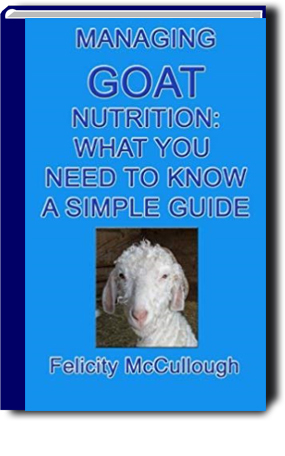Goat Diet
Managing Goat Nutrition What You Need To Know A Simple Guide
The quality of the roughage the goats eat. Goats that eat fresh browse, green asture, or good hay need less concentrate than goats that get little or no browse or pasture and poor-quality hay.
Each goat's physical condition. A well-conditioned goat is fleshed out but not too fat. A dairy goat is too fat when you can't feel her ribs. A fiber goat or meat goat is too fat when you can grab a handful of flesh behind the elbow.
If a goat is too thin, feed more grain. If a goat is too fat, feed less grain.
The goat's age. Let kids nibble on concentrate as soon as they are interested. At first, they will just mouth the ration with their lips, but as they grow they will learn to relish their little taste of grown-up feed. After the kids are weaned, gradually work up to 1 pound of concentrate per day. When feeding any goat 1 pound or more per day, divide the concentrate into two feedings, morning and evening.
Feeding too much concentrate at once upsets the rumen's balance.
The goat's level of production. Mature goats that are not pregnant or lactating require a maintenance ration that provides just enough nutrients to maintain the animalís health and body weight. A maintenance ration for wethers and open dry does on good browse or pasture need not include concentrate. A supplemental feeding of 1/4 to 1/2 pound (1 to 2 cups) of concentrate per day, however, increases the growth rate of a meat goat, improves the hair growth of a fiber goat, and keeps all goats easier to handle because they look forward to your regular visits with the feed.
Open dry does, or wethers, raised in confinement may be fed up to 1 pound of concentrate per day. The same applies to open dry does and wethers that normally browse or graze, but whose feeding pattern is disrupted by bad weather, or whose forage supply has been curtailed by drought. Since open dry does and wethers have low nutritional requirements, you may save money by feeding them shelled corn, barley, oats, wheat, sorghum, or milo instead of commercial concentrate. Whole grains that are dry and hard, do not digest as well as grains that have been rolled, crimped, cracked, or flaked.
A pregnant dry doe that is not a dairy breed, should be kept on a maintenance ration until 6 weeks before she gives birth. Then feed her a little concentrate, gradually increasing the amount to 1 pound. After she gives birth, continue feeding 1 pound a day (1 1/4 pounds if she has twins) until her kids are 6 weeks old, then begin gradually decreasing the concentrate. By the time her kids are 3 months old, the doe should be back on a maintenance ration.
Managing Goat Nutrition What You Need To Know A Simple Guide
 |
 |
 |
 |
 |
 |
 |
 |
 |
 |
 |
 |
 |
Goat Lap Shop Home
Other Goat Articles
Photographic credits:
Goats, goat, roughage, browse, green asture, hay, concentrate, browse, pasture, poor-quality hay, physical condition, fleshed out, fat, dairy goat, too fat, ribs, fiber goat, meat goat, flesh, elbow, thin, feed, grain, fat, grain, age, kids, concentrate, interested, ration, lips, kids are weaned, rumen, production, Mature goats, pregnant, lactating, maintenance ration, nutrients, animalís health, body weight, wethers, dry does, good browse, pasture, supplemental feeding, growth rate, meat goat, hair growth, fiber goat, easier to handle, does, wethers, raised in confinement, browse or graze, feeding pattern, forage supply, drought, nutritional requirements, shelled corn, barley, oats, wheat, sorghum, milo, commercial concentrate, Whole grains, digest, grains, rolled, crimped, cracked, flaked, pregnant dry doe, dairy breed, birth, twins,

How to feed goats well?

